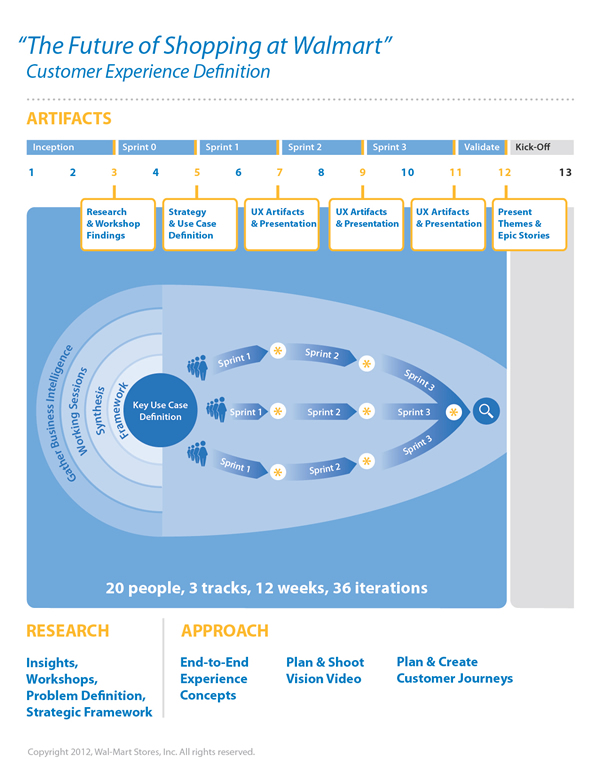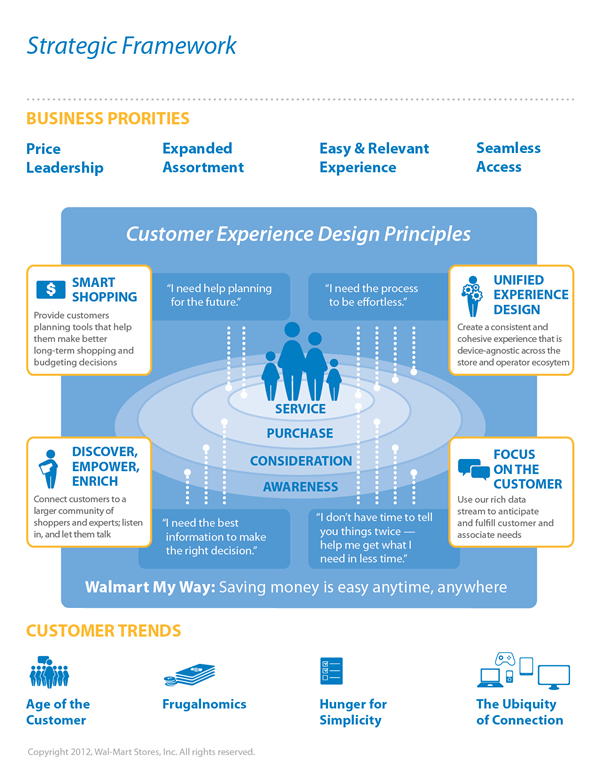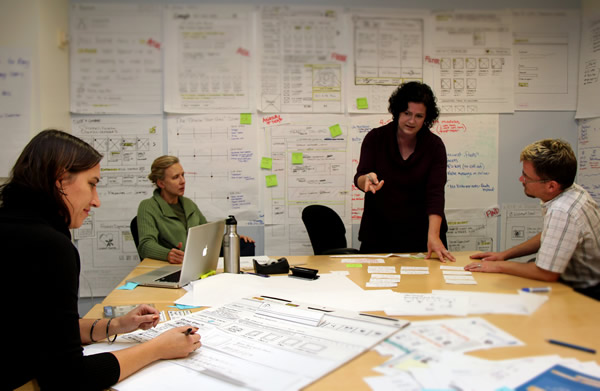My senior executives once approached me with the question: What will it be like to shop on Walmart.com in the future? They came to me with this challenge because they were looking for something beyond the typical product roadmap or strategic business plan; they wanted an innovative, customer-focused vision expressed in a manner powerful enough to rally a global organization of approximately 2.2 million people. I didn’t have a long timeline or large budget for this special assignment. I did, however, have twelve weeks and twenty deeply experienced UX practitioners. This article provides key learnings from this Future of Shopping at Walmart project.
Recognizing Business Intelligence
Build Your Foundation with Facts
Intuition, creativity, and divergent thinking are some of the unique skills UX designers bring to vision efforts. However, to be credible at the highest executive level, it is essential to be grounded in facts about industry trends, competitive threats, and shifts in consumer behavior. Making it a priority early on to immerse yourself in strategic facts will keep you and your team grounded as you collaborate with a broad set of opinionated stakeholders during the high-level design phase of a project.
When I laid out my twelve-week plan for addressing the Future of Shopping at Walmart project (see Figure 1), I made sure to reserve the first two weeks of our timeline for conducting strategic research to establish a foundation of facts about online, mobile, and physical shopping behaviors and trends.

We gathered business intelligence about online and physical store retail trends from our internal research teams and industry analysts. We consolidated metrics about our stores, sales associates, and technology adoption rates. We investigated macro-trends such as “frugalnomics,” an emerging dynamic in consumer behavior led by the global economic crisis that is driving intense competition and consolidation in the low-cost shopping space.
During this intense two-week inquiry period, we began to uncover what our unique competitive advantages could be in this new age of the empowered customer who has easy access to product and price information.
If Necessary, Redefine the Problem
What we discovered in our initial strategic research pointed us to a bigger question: What would it be like to shop at Walmart—not just Walmart.com—in the future?
More specifically, we learned that with the mass adoption of smartphones, the lines between brick-and-mortar and digital shopping experiences blur. This means that customers don’t want to shop by channel, they want to shop whenever they want and however they want. With instant access to information about price, product, social sentiment, and customer reviews, today’s customer is always right.
Make It Simple to Get on Board
When wrapping up the research stage, avoid overwhelming your stakeholders with details as you establish a strategic framework. As a design leader, it’s your job to synthesize facts into new insights expressed in a manner that is easy for others to understand, internalize, and act on.
Using what we discovered through research, we developed a visual strategic framework that could be captured on one sheet of paper (see Figure 2). It consisted of a summary of customer behavior trends, our strategic business priorities, and a set of experience design principles.

by developing a strategic framework that can be used for future tactical decision making.
Engaging our leaders early in the development of our strategic framework made the process of redefining the problem statement collaborative. Rather than reject our redefinition of the problem we were solving, our stakeholders embraced it. In fact, at one point, the CEO of Walmart.com asked us to create a piece of alignment collateral for his organization. One side displays the strategic framework we developed, and the other side displays the annual goals he set for his team.
Managing Relationships
Nurture Your Team
The most important relationship to establish and nurture during a UX project like the one presented here is your relationship with the UX team you lead. It is essential that you and your team trust each other; trust is the essential ingredient to a dynamic, collaborative work environment where a team feels supported and works together to take risks, fail fast, learn, and iterate.
In the case of setting a vision for the Future of Shopping at Walmart project, I put my team outside their comfort zone in working on tactical problems and challenged them to work with me to create a vision (see Figure 3). I built trust with my team through accountability for framing and guiding the project to be successful. My clear commitment to the team was to get the problem definition right, get the foundation of facts established early, and help them land the execution. On a daily basis I asked tough questions to stretch the quality of their thinking. I also set high expectations and demonstrated confidence in my team to deliver their best. I believed in them, and so they believed in themselves.

It is important to be vulnerable as a leader in order to keep the lines of communication open. But when things get tough, you must not fret in front of your team or stakeholders. To deepen trust in the face of project challenges, I created platforms to openly discuss roles, goals, and fears, so that if things went wrong, I was prepared to manage the outcome well.
Build a Broad Relationship Map and Use It
In an internal user experience team, you have relationships with business people, product managers, engineers, and researchers that reach back to past efforts and are sustained well beyond specific, current projects. Capitalize on this. Tap into institutional knowledge and experience across the enterprise. Reach out to internal and external networks and ask about priorities, initiatives, and ideas that present opportunities to integrate and highlight ideas already underway.
During the Future of Shopping at Walmart project, I worked well outside my span of control to connect dots and influence outcomes. For example, I don’t directly lead the mobile efforts of our enterprise, but roughly 60 percent of what I was surfacing in this strategic undertaking was about the growing role of mobile in making shopping easier between channels and retailers for our customers. Today, key mobile experience design concepts we expressed in our vision work are being tested and launched.
Leverage Your Network, and Give Your Network Leverage
Knowing who in your organization is passionate about reducing friction for customers, driving growth and innovation, and reducing costs allows you to rapidly assimilate data from their efforts (and understand their perspective and concerns). By recognizing and incorporating their work, you are building a relationship framework that you can tap into for support as you make a case for change. You’ll be engaging these stakeholders as partners and, in return, they will become evangelists for your vision.
In my own journey to build and express a customer experience vision for the Future of Shopping at Walmart project, my relationships with internal stakeholders across the organization were crucial. For example, I relied on stakeholders to understand operational details to illustrate what needed to change about how technology is used in physical stores to better integrate with our website and mobile technology.
It never ceases to amaze me that you can work at a large company for a significant period of time and continue to discover new teams working on innovative efforts related to yours. If you fail to seek out connections and forge relationships, you risk creating strategic work that is not informed by, or aligned with, the subject matter experts in your organization. Even worse, you will appear to be organizationally tone deaf when presenting your work to top leaders who possess a broader perspective on company strategy.
Communicating
Communicate to Influence and Inspire Commitment
Communication is the essence of a great UX leader. As designers, we learn to present our work and respond to critiques. As leaders, we learn to listen and think critically about what we hear and see in customer behaviors and in the broader business landscape. Then we artfully translate business problems into design opportunities. We are ultimately using design processes to deliver strategic solutions that our stakeholders understand before they buy in. Therefore, our solutions should be defensible in a business context.
Be sure that you step back and clearly lay out your rationale to stakeholders. Be clear about how you leveraged specific customer insights, industry data, and business objectives and how you were deliberate in the synthesis of ideas to arrive at your strategic solutions. When I presented concepts that showed how mobile devices make shopping easier for our customers, I supported my team’s discoveries and ideas with business metrics on customer smartphone adoption rates.
This approach placed the innovative ideas my team developed in the context of the business landscape our stakeholders operate in. In this way, the experience design concepts were transformed into business solutions.
Frame Your Vision to Build Organizational Alignment
One of the major challenges I faced when I reframed the Future of Shopping at Walmart problem statement was one of organizational alignment. I tackled this issue by breaking down internal channel definitions and positioning our vision for the future of shopping as combining the best of digital and physical shopping experiences. In this way, as one united organization, we target growing all online-influenced offline sales, the most rapidly growing share of total retail sales.
We developed a set of richly detailed customer journeys, a tactic to express core use cases through stories about how customers will shop with us in the future, that put our stakeholders in the shoes of customers. In this manner we built empathy for our customers, and the problems we sought to solve for them, while highlighting disruptive ideas, design, and technology solutions that could differentiate our company. We tied it all back to the strategic framework and design principles developed in the first two weeks of the effort.
Don’t Underestimate the Power of Storytelling
As a leader, you must possess the ability to construct and tell a compelling and genuine story about your vision that motivates people to become part of realizing it. Storytelling is a uniquely human mechanism that can relay rich, complex information in a universally accessible manner.
In order to reach worldwide Walmart employees with our story about the future of shopping, we created a three-minute video that shows the vision of how web, mobile, and sales associates work together in new ways to provide a seamless shopping experience that only our company can deliver. The video has since taken on a life of its own, which is a testament to the power of storytelling to relate a compelling picture of the future.
It’s a Wrap
When you take your place at the strategy table as a UX leader, lean in and ground yourself in your deep understanding of customer behavior. Make it central to how you express your product strategy. This customer-focused approach will allow you to provide unique value to the master plan when you practice and evolve the three conventional business skills that I shared from my journey. Do you have UX strategy leadership tips to share?从用户体验从业者转变为创新和思想领导者是一个具有挑战性的过程。以用户为中心的设计工具箱中包含很多技巧,可帮助您成功实现过渡。发掘用户体验技巧的价值,如同理心思考、整体思维和叙述故事经验,再加上对沟通的投入,可以帮助您在产品战略领域取得一席之位,为公司谋划真正切实的未来。
文章全文为英文版
UX 실무자에서 혁신과 사고의 리더로 옮겨가는 것은 어려운 일입니다. 사용자 중심 디자인 방법들의 기술을 통해서 이러한 일을 성공적으로 수행할 수 있습니다. 커뮤니케이션에 대한 열정적 헌신과 더불어 공감, 종합적 사고, 스토리텔링과 같은 사용자 경험 방법기술 들의 가치를 안다면, 제품 전략 회의에 참석하여 회사의 진정한 미래를 설계하는 데 도움이 될 수 있습니다.
전체 기사는 영어로만 제공됩니다.
É um desafio passar de praticante da experiência do usuário para líder em inovação e ideias inovadoras. As habilidades do conjunto de ferramentas do projeto centrado no usuário podem ajudá-lo a ter sucesso na transição. Descobrir o valor de habilidades em experiência do usuário como empatia, pensamento holístico e narrativas, combinadas a um compromisso profundo com a comunicação, pode ajudá-lo a ocupar uma cadeira na mesa de estratégia de produto e projetar o futuro real de sua empresa.
O artigo completo está disponível somente em inglês.UXデザインの担当者の立場から、業界におけるイノベーションとオピニオンリーダーの立場へ移行することには困難が伴うが、ユーザ中心設計のデザインツールキットから得られるスキルを身に付けることが、この移行プロセスに役立つ。共感、全体的な思考、ストーリーテリングなどのユーザエクスペリエンススキルの価値を見出し、それらをコミュニケーションへの深いコミットメントと組み合わせることによって、製品戦略に参加し、極めて現実的な将来を設計することが可能となる。
Pasar de ser un profesional especializado en experiencia de usuario (UX, por sus siglas en inglés) a un líder en innovación e ideas es todo un desafío. Las aptitudes del kit de herramientas de diseño centrado en el usuario pueden garantizarle el éxito en esta transición. Descubrir la importancia de las aptitudes relacionadas con la experiencia de usuario como la empatía, el pensamiento holístico y la narración de historias, combinadas con un profundo compromiso con la comunicación, pueden ayudarle a ocupar un lugar en la conversación sobre las estrategias de productos y a diseñar el futuro real de su empresa.
La versión completa de este artículo está sólo disponible en inglés
